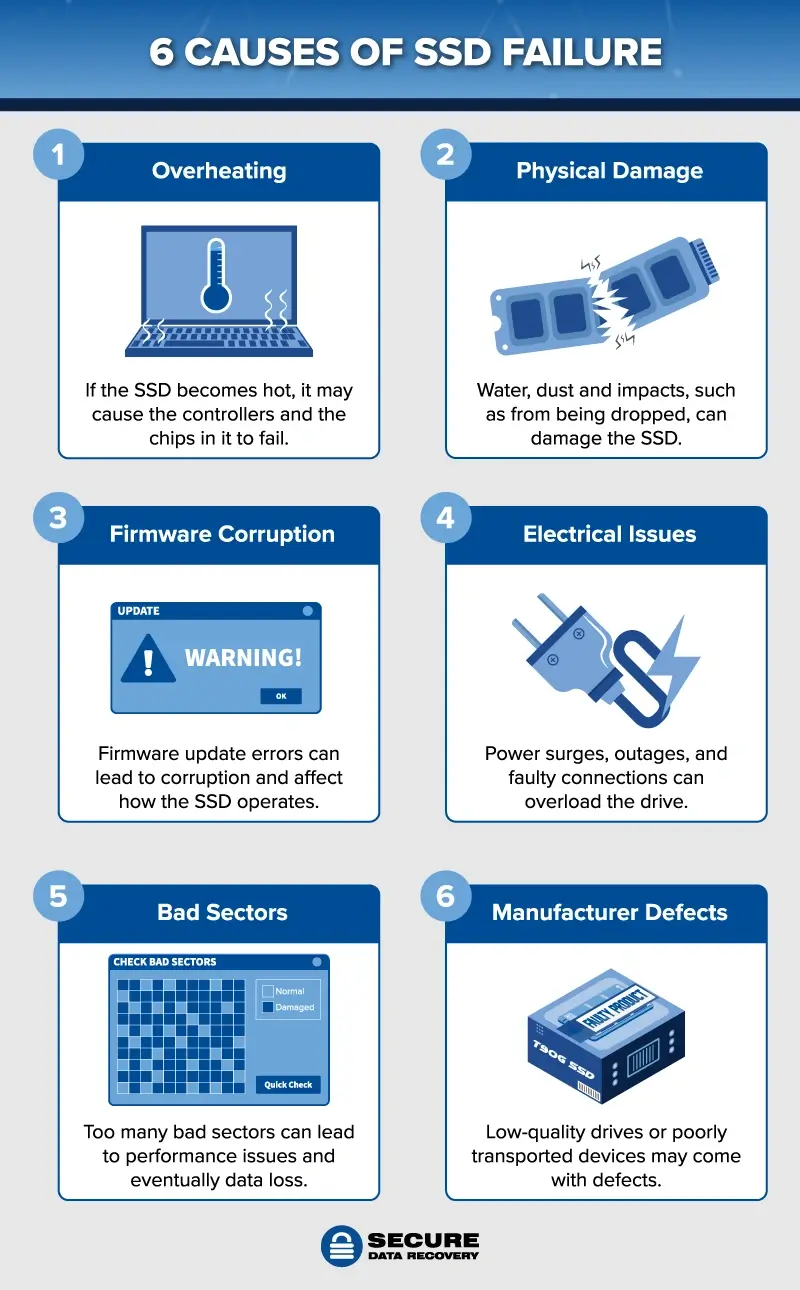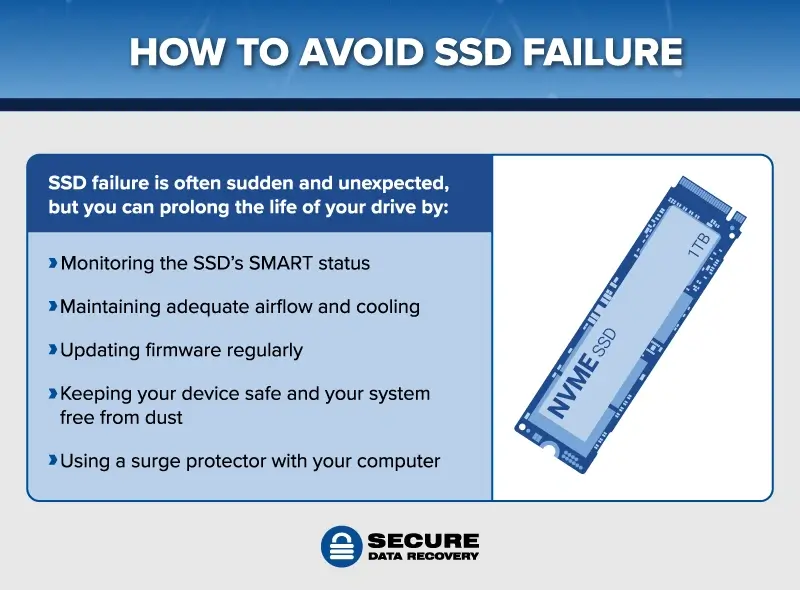Although SSDs (solid state drives) are a reliable way to store data, they can still fail — and when they do, it often happens suddenly. However, to avoid being totally blindsided, there are some warning signs you can look out for and causes of failure you can avoid.
Although they don’t have moving parts, SSDs are more complex than hard disk drives (HDDs), so if they fail, it can be difficult to recover important data. If this happens, your best chance is to use a professional SSD data recovery service.
This post explains the most common causes of SSD failure as well as the warning signs you may see leading up to it.
6 Common Causes of SSD Failure
SSDs can fail for a variety of reasons. Here are some of the most common causes of SSD failure.
1. Controller or Chip Failure Due to Overheating
A common cause of drive failure for an SSD is overheating. Raised temperatures can cause the controllers and the chips in it to fail and the SSD to stop working. This could happen due to its own operation or because it's placed around other components that generate heat, such as tightly placed in a laptop.
SSDs also can reportedly lose data if left unplugged for a long time. The lack of electrical charge affects the characteristics of the cells and can impact the health of your SSD. Hot temperatures might expedite this process too, like if you leave your device unattended for an extended period in a particularly hot environment.
2. Physical or Environmental Damage
SSDs don’t have moving platters like hard drives, so they’re more resilient to physical damage than traditional HDDs. However, physical force and environmental factors can still cause your SSD to fail. For example:
3. Firmware Corruption
If the SSD’s firmware gets corrupted, it can affect your device’s data storage and whether the drive or file system is accessible. Firmware update errors are often to blame.
The wear levelling, which is crucial to your SSD lifespan, can get corrupted as well. SSDs use wear levelling to use memory cells for write cycles and erase cycles evenly, spreading the use across all cells to enhance the longevity of the drive. But if the wear levelling algorithm is corrupted, it spreads among the cells and can affect how fast the SSD wears out.
4. Power Surges and Electrical Issues
A sudden power outage, insufficient power supply, or power surge, such as from a storm, can overload the drive, fry the circuits, and lead to corruption. Faulty wiring or connections can also cause problems, like if cables are not secured or if the SSD is not properly seated.
5. Too Many Bad Sectors (Bad Blocks)
Bad sectors, also known as bad blocks, are parts of the storage space that have become defective. SSDs are usually shipped with some bad blocks, but they don’t affect their performance because the firmware tracks them. However, if the number increases, it may lead to SSD failure.
Bad sectors can be created by the other causes on this list, such as physical damage and power surges, so it’s usually not just one but a combination of these causes over time that lead to SSD failure.
6. Manufacturer Defects
Occasionally, SSD components can fail due to manufacturing defects from the design or production process. Usually, this is only a problem with low-quality or counterfeit drives, but it does occasionally affect the larger manufacturers. There may also be issues caused by how the devices are transported to the retailer.
Warning Signs That Your SSD May Fail
Often when an SSD fails, it’s quite sudden, but there are some signs of SSD failure that you can look out for:
Most modern SSDs come with Self-Monitoring, Analysis, and Reporting Technology (SMART) technology. This is a system built into the device that provides insights into issues such as wear, bad sectors, unexpected power losses, and temperature issues. If there are issues, it will likely show a warning. Your SSD should also come with a manufacturer software tool that monitors it, which you usually install upon starting use.
How to Avoid SSD Failure
While it isn’t always completely unavoidable, here are some tips that can help to protect your data by preventing SSD failure:
Do SSD Drives Fail Due to Overuse?
It’s often assumed that SSDs will fail because they have a limited lifespan. NAND flash memory cells do have a finite number of write and erase cycles, so each time you write data to an SSD it causes wear, and the ability of the cells to retain data reduces.
However, modern SSDs rarely reach their own limits through regular usage because they have levelling firmware that spreads the usage of the writes among cells to “even out” the wear.
This means the average consumer usually doesn’t have to worry about overusing their drive, and if the drive does fail, it’s likely due to another error, rather than because it just degraded over time.
Can You Fix a Failed SSD?
Because SSDs don’t have moving parts, it takes an advanced skill set to diagnose and fix any damage or defects.
If you think your SSD has failed, try rebooting your computer and checking all connectors and power cables. If this doesn’t work and you need to recover your data from your SSD, your best option is to contact a professional service like Secure Data Recovery.
Get Your Lost Data Back
Although it makes a great storage solution, SSD failure is incredibly stressful, especially if it happens suddenly. Our SSD Data Recovery service can help you navigate the issue and mitigate your data loss. Our team has the expert knowledge to address problems with SSDs. We have a 96% success rate with data recovery — and if we can’t recover your data, you won’t have to pay our fee.













